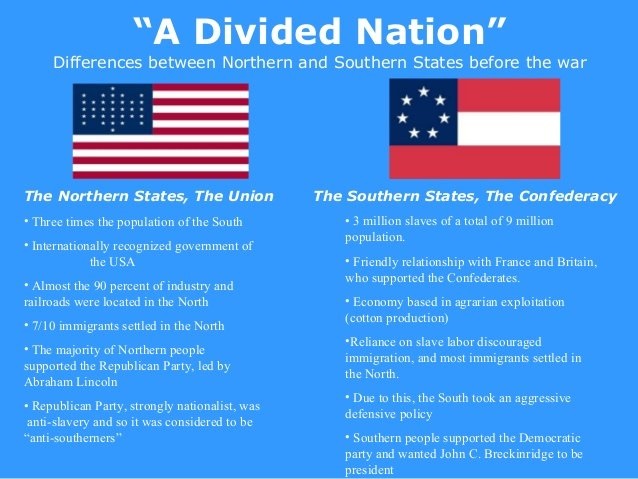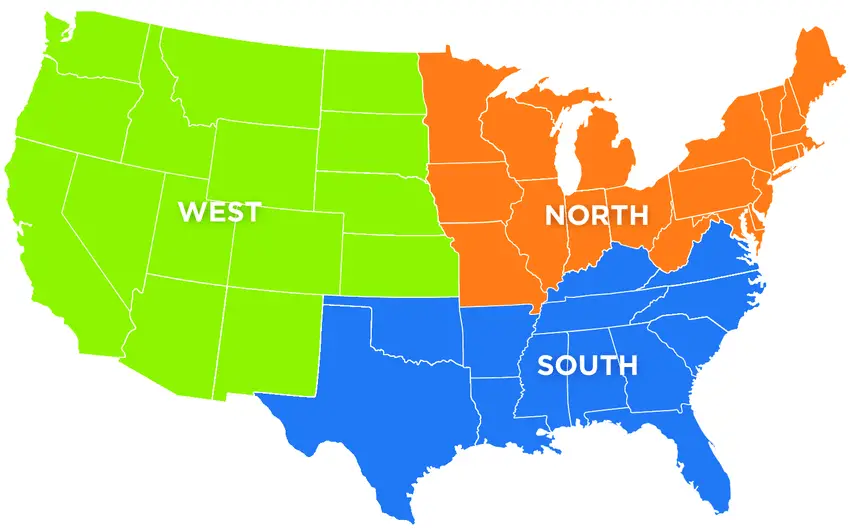Northerners in the USA are often seen as direct, fast-paced, and individualistic, valuing efficiency and professionalism. Southerners, on the other hand, are typically viewed as more hospitable, family-oriented, and community-minded, valuing manners and social connections.
Explanation of the North-South Divide in the USA
The North-South divide in the USA generally refers to cultural and economic differences between the Northern and Southern regions of the country. Historically, the divide was most pronounced during the Civil War, when the North and South fought over issues including slavery, states’ rights, and economic policies. Today, the divide is less stark, but there are still some cultural differences between the two regions, such as accents, food preferences, and political beliefs. The South is generally more conservative and rural, while the North is more liberal and urban. The two regions also have different industries and economic priorities, with the South being known for agriculture, manufacturing, and energy production, while the North has a more diverse economy, with a strong focus on technology, finance, and healthcare. However, it’s important to note that the North-South divide is a complex issue, and there is significant cultural and economic diversity within each region.
Historical Background of the North-South Divide in the USA
Here are some key points on the historical background of the North-South divide in the USA:
- Slavery was a key issue in the divide between North and South leading up to the Civil War. The North, which had a more industrialized economy, largely opposed slavery, while the agrarian South relied heavily on enslaved labor.
- The North and South also had different views on states’ rights and the role of the federal government. The South believed in a weaker federal government and greater autonomy for states, while the North favored a stronger federal government and national unity.
- The Civil War, which lasted from 1861 to 1865, was fought largely over these issues, with the North ultimately victorious. The war resulted in the abolition of slavery and a significant expansion of federal power.
- Following the Civil War, the South faced a period of Reconstruction, during which the federal government attempted to rebuild the region and ensure civil rights for freed slaves. However, this was met with resistance from many Southerners, and the region remained economically and socially disadvantaged for many years.
- The North and South continued to diverge in terms of culture and economics throughout the 20th century. The South remained largely rural and agricultural, while the North became more industrialized and urban.
- In recent decades, the North-South divide has become less pronounced, as both regions have become more diverse and globalized. However, there are still some cultural and economic differences between the two regions.
Geographical and Demographic Differences

Geographical and demographic differences are key factors that contribute to the North-South divide in the USA. Here are some of the main differences:
Geography:
- The South is generally more rural and agrarian, while the North is more urban and industrialized.
- The South has a warmer climate and more fertile soil, making it better suited for agriculture, while the North has a colder climate and more varied terrain.
- The South has a longer growing season, which allows for more crops to be grown throughout the year.
Demographics:
- The South has a higher proportion of African Americans and a larger evangelical Christian population than the North.
- The North has a higher proportion of immigrants and more diversity in terms of race and ethnicity.
- The South has a higher birth rate and a lower overall population density than the North.
These geographical and demographic differences have contributed to the development of distinct cultural and economic identities in each region, as well as differences in political and social attitudes. However, it’s important to note that there is significant diversity within each region, and not all individuals fit neatly into these generalizations.
Cultural Differences of Northerners and Southerners
There are cultural differences between Northerners and Southerners in the USA, although it’s important to remember that these are generalizations and there is significant diversity within each region. Here are some of the cultural differences that are often observed:
- Manners and hospitality: Southerners are often viewed as more polite and hospitable, placing a high value on manners and etiquette. They may also be more likely to invite guests into their homes and offer food and drink. Northerners are generally more direct and less concerned with formality and social graces.
- Speech and accents: There are distinct accents and dialects associated with each region. Southerners are known for their drawling, melodic accents, while Northerners may speak more quickly and have a flatter tone.
- Food: Each region has its own cuisine and culinary traditions. Southerners are known for comfort foods like fried chicken, barbecue, and grits, while Northerners may favor more international and health-conscious cuisine.
- Religion: The South has a larger population of evangelical Christians and may place a greater emphasis on religious faith than the North.
- Politics: The South is generally more conservative, while the North is more liberal. This divide is reflected in the political leanings of each region, as well as the social and cultural issues that each region prioritizes.
Lifestyle Differences of Northerners and Southerners
There are lifestyle differences between Northerners and Southerners in the USA, although it’s important to note that there is significant diversity within each region and not all individuals fit neatly into these generalizations. Here are some of the lifestyle differences that are often observed:
- Climate and outdoor activities: The South generally has a warmer climate and longer growing season, which allows for more outdoor activities like gardening, hunting, and fishing. The North, with its colder climate, may place more emphasis on indoor activities like cultural events and museums.
- Work-life balance: The South may place a greater emphasis on work-life balance and leisure time, with a slower pace of life and more time spent with family and friends. The North may have a faster pace of life and place more emphasis on career success and achievement.
- Fashion and style: Southerners are often associated with a more casual, relaxed style of dress, while Northerners may place more emphasis on fashion and dressing up.
- Housing and architecture: The South may have more traditional housing styles, like plantation homes and craftsman-style bungalows. The North may have more modern and urban housing options, like loft apartments and brownstones.
- Sports and recreation: The South may place more emphasis on college football and NASCAR, while the North may be more focused on professional sports like baseball and basketball.
Popular Stereotypes of Northerners and Southerners
There are many popular stereotypes of Northerners and Southerners in the USA, some of which are based in reality and others that are simply caricatures. Here are a few examples:
Stereotypes of Northerners:
- Rude and impatient: Northerners are often portrayed as being direct to the point of rudeness, and not willing to tolerate slow Southern manners and hospitality.
- Workaholic and stressed: Northerners may be seen as having a fast-paced, high-pressure lifestyle with little time for leisure.
- Intellectual and sophisticated: Northerners may be perceived as more educated and cultured, with a preference for the arts and intellectual pursuits.
- Unfriendly and cold: Northerners may be seen as aloof and unfriendly, not inclined to make small talk or engage in socializing.
Stereotypes of Southerners:
- Polite and hospitable: Southerners are often portrayed as being gracious and welcoming, with a strong emphasis on manners and hospitality.
- Slow-paced and laid-back: Southerners may be seen as enjoying a slower pace of life, with more time for leisure and relaxation.
- Religious and traditional: Southerners may be perceived as being more religious and conservative in their values and beliefs.
- Unsophisticated and uneducated: Southerners may be stereotyped as being less sophisticated and less educated than their Northern counterparts.
Conclusion
In conclusion, the North-South divide in the USA is a complex phenomenon that has its roots in history, geography, and culture. The divide is characterized by differences in values, beliefs, lifestyles, and politics, with each region having its own distinct identity and traditions. While there are certainly stereotypes associated with Northerners and Southerners, it’s important to remember that these are generalizations, and individuals within each region are diverse and unique.
References:

